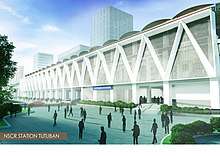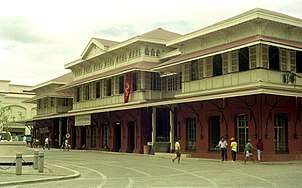Tutuban railway station
Tutuban | ||||||||||||||||||||
|---|---|---|---|---|---|---|---|---|---|---|---|---|---|---|---|---|---|---|---|---|
| Philippine National Railways | ||||||||||||||||||||
|
Exterior of the PNR Executive Building on Mayhaligue Street, which today serves as the PNR's Tutuban station terminal. | ||||||||||||||||||||
| Other names | Manila, Tayuman, Divisoria | |||||||||||||||||||
| Location |
PNR Executive Building, Mayhaligue Street Tondo, Manila | |||||||||||||||||||
| Coordinates | 14°36′41″N 120°58′24″E / 14.6114°N 120.9732°ECoordinates: 14°36′41″N 120°58′24″E / 14.6114°N 120.9732°E | |||||||||||||||||||
| Owned by |
Department of Transportation and Communications Philippine National Railways | |||||||||||||||||||
| Line(s) | Northrail (1891-1997), Southrail, Antipolo line (defunct), Caloocan shuttle line | |||||||||||||||||||
| Platforms | 3 island platforms | |||||||||||||||||||
| Tracks | 6 | |||||||||||||||||||
| Construction | ||||||||||||||||||||
| Disabled access | Yes | |||||||||||||||||||
| Other information | ||||||||||||||||||||
| Station code |
TU (commuter) MA (intercity) | |||||||||||||||||||
| History | ||||||||||||||||||||
| Opened | March 24, 1891 | |||||||||||||||||||
| Rebuilt | 1996 | |||||||||||||||||||
| Services | ||||||||||||||||||||
| ||||||||||||||||||||
PNR Metro Commuter |
|---|
North-South Commuter Line |
Tutuban station commonly as Manila railway Station or Divisoria railway Station is the main train station of the Philippine National Railways (PNR) and the main train station of the city of Manila in the Philippines. It was formerly known as the Manila Railroad Company (MRRCo). The name refers to two stations: the original Tutuban station, which today forms part of the Tutuban Centermall, and the PNR Executive Building, which houses PNR offices and serves as the current terminus of all PNR services.
History

As part of the "Ferrocarril de Manila-Dagupan" or Manila-Dagupan Line, which constitutes much of the North Main Line today. The cornerstone of the main station building at Tutuban was laid on 31 July 1887.[1] The railway was 195 kilometers long at the time of its opening on November 24, 1892, running from Manila to Dagupan City in Pangasinan. The Manila Railroad Company was changed to the corporate name Philippine National Railways due to the enactment of the Republic Act No. 4156.[2]
In 1988, PNR evaluated the possibility of renting 22 hectares of land to Tutuban at Claro M. Recto in response to the challenges of development and help promote the site to be the center of trade. PNR implemented the first part of the master development plan of Tutuban Properties, Inc. in 1991, and later entrusted the management and development of the land. The Tutuban Center Mall was formally inaugurated to the public led by Fidel V. Ramos on February 21, 1994.
The following years has witnessed the continued efforts among PNR, Tutuban Properties, Inc. and the Philippine Government to advance the methods of travel by reorganizing the overall railroad system, improve the civic and business buildings around the Tutuban, and keep emphasis on history. The development of PNR Plaza is a step to verify the cause of reactivating the overall railroad system as one method of travel and trading.
The Tutuban Station Executive Building was inaugurated on May 30, 1996.
The Tutuban station will be renovated to become more transit-oriented and a newer station will be built for the North-South Commuter Railway or Manila-Clark Railway (or both) while the 1996 station will only serve the Manila-Legazpi long-haul provincial services, if revived.
Gallery
- Philippine National Railways Logo
- Facade
- Vintage 0-6-0 "Dagupan" steam locomotive
 Exterior of the original Tutuban station built in 1892, which today is part of the Tutuban Centermall
Exterior of the original Tutuban station built in 1892, which today is part of the Tutuban Centermall Facade of the PNR Tutuban station
Facade of the PNR Tutuban station Platform 2
Platform 2- Interior of Tutuban Center with the existing columns of the Old Tutuban Railroad Station
- Historical marker of the Tutuban Center Mall
- Iron Corinthian column at Tutuban Center Mall
- Restored lobby wall of the former Tutuban Railroad Station
- Lobby of the current PNR Tutuban Station
- Historical marker at the new PNR Tutuban Station
- PNR Depot
- Facade of the old Tutuban station. Currently the Tutuban Center Mall
- PNR gallery
- Tutuban Center Mall. Formerly the Tutuban Railway Station facade
Station layout
| L1 Platforms | ||
| Platform A | PNR Metro Commuter towards Calamba or Depot (→) | |
| Island platform, doors will open on either the left or the right | ||
| Platform A | PNR Metro Commuter towards Alabang or Depot (→) | |
| Platform B | PNR Metro Commuter towards Alabang or Depot (→) | |
| Island platform, doors will open on either the left or the right | ||
| Platform B | PNR Metro Commuter towards Alabang or Depot (→) | |
| Platform C | PNR Metro Commuter towards Alabang or Depot (→) | |
| Island platform, doors will open on either the left or the right | ||
| Platform C | PNR Caloocan Line towards Caloocan or Depot (→) | |
| L1 | Concourse | Ticket Booths, Station Control, shops, Depot, Main Office, Bicycle, Bus, FX, Jeepney, Taxi and Tricycle Transport Terminal |
See also
References
- ↑ "Philippine National Railways; Main Lines on Luzon". Geocities. Retrieved 3 May 2014.
- ↑ "PNR in Philippine History". Philippine National Railways. Archived from the original on 19 February 2015. Retrieved 3 May 2014.
External links
| Wikimedia Commons has media related to Tutuban railway station. |